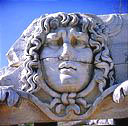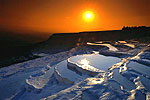
| |
|
|
Ephesus
Tour
|
|
 The
tour begins by visiting the remains of the Artemis
Temple, one of the seven wonders of the ancient world. Afterwards,
it proceeds to the spectacular main site of Ephesus,
undoubtedly the most superbly preserved Greco-Roman city. Unmistakable
highlights surviving among the ruins are the Celsius Library, Agora,
Theater, Odeon, Trajan Fountain, Domitianus Temple and Roman Latrines.
Following a lunch break, visit the House of
Virgin Mary; reputed to be where she spent her final days. The
tour begins by visiting the remains of the Artemis
Temple, one of the seven wonders of the ancient world. Afterwards,
it proceeds to the spectacular main site of Ephesus,
undoubtedly the most superbly preserved Greco-Roman city. Unmistakable
highlights surviving among the ruins are the Celsius Library, Agora,
Theater, Odeon, Trajan Fountain, Domitianus Temple and Roman Latrines.
Following a lunch break, visit the House of
Virgin Mary; reputed to be where she spent her final days. |
|
|
Priene,
Miletus & Didyma Tour
|
|
 Begin
the day among the Hellenic art and architecture of the ruins in
Priene, an ancient Ionian city dramatically
overlooking the fertile plains of the Meandre Valley. Afterwards,
continue to the second archaeological site of the day; the ancient
city of Miletus, formerly a prosperous commercial harbor
city and the most prominent in Anatolia in its heyday. Most noteworthy
among the scattered ruins are the Great Theater and Roman Baths.
Eventually, the tour reaches Didim town, where there is time for
an open buffet lunch. Following that, the tour proceeds to the ancient
city of Didyma, the setting for one of the most colossal
temples in the Hellenic World, venerating the God Apollo. Begin
the day among the Hellenic art and architecture of the ruins in
Priene, an ancient Ionian city dramatically
overlooking the fertile plains of the Meandre Valley. Afterwards,
continue to the second archaeological site of the day; the ancient
city of Miletus, formerly a prosperous commercial harbor
city and the most prominent in Anatolia in its heyday. Most noteworthy
among the scattered ruins are the Great Theater and Roman Baths.
Eventually, the tour reaches Didim town, where there is time for
an open buffet lunch. Following that, the tour proceeds to the ancient
city of Didyma, the setting for one of the most colossal
temples in the Hellenic World, venerating the God Apollo. |
|
|
Pergamon
Tour
|
|
 Upon
arrival in the ancient city of Pergamon,
enter the Red Court, a precinct of
successive religious worship - evident in the various transformations
of a formerly pagan temple to a Byzantine basilica, eventually to
a mosque. Following a lunch break, drive up to the Asclepion
on the hilltop, once a world-renowned medical center of physicians
and scholars. Afterwards, visit the impressive remains of the Acropolis. Upon
arrival in the ancient city of Pergamon,
enter the Red Court, a precinct of
successive religious worship - evident in the various transformations
of a formerly pagan temple to a Byzantine basilica, eventually to
a mosque. Following a lunch break, drive up to the Asclepion
on the hilltop, once a world-renowned medical center of physicians
and scholars. Afterwards, visit the impressive remains of the Acropolis.
|
|
|
Pamukkale
& Aphrodisias Tour
|
|
|
|
|
 The
tour begins among the ancient ruins of Aphrodisias,
where Aphrodite - the Goddess of love and fertility was worshipped.
Following a lunch break, the tour picks up again at Pamukkale,
or 'Cotton Castle', the name so derived as a result of the calcium
deposited terraced travertines, which cascade in snowy white down
the mountain side slopes. Visit these travertines as well as the
nearby ruins of the ancient city of Hieropolis.
Finally, there is time set aside for a relaxing swim in one of
the more unusual hot pools supplied by the natural springs - marked
by a splendid scattering of ancient stone columns underwater and
around.
The
tour begins among the ancient ruins of Aphrodisias,
where Aphrodite - the Goddess of love and fertility was worshipped.
Following a lunch break, the tour picks up again at Pamukkale,
or 'Cotton Castle', the name so derived as a result of the calcium
deposited terraced travertines, which cascade in snowy white down
the mountain side slopes. Visit these travertines as well as the
nearby ruins of the ancient city of Hieropolis.
Finally, there is time set aside for a relaxing swim in one of
the more unusual hot pools supplied by the natural springs - marked
by a splendid scattering of ancient stone columns underwater and
around.